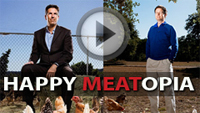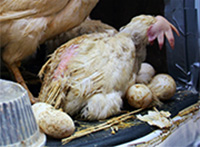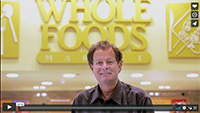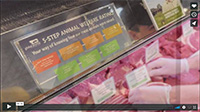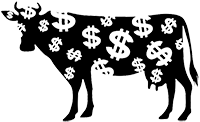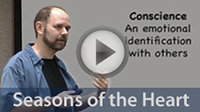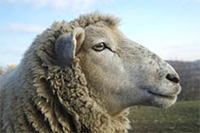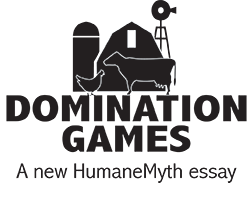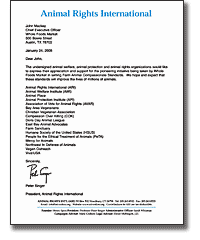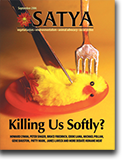
| Home | About | FAQs | Feedback | Take Action | Downloads | MythWatch | Advanced Advocacy | Store |
|
Re-examining the ideas and actions of Wayne Pacelle,
|
As we write these words, there are individuals in the US animal movement who are being harmed or have been harmed by abuses of power carried out by those with high levels of influence and status. Secrets, lies, and aggressive suppression of criticism have enabled personal damage and betrayal of public trust to continue. As a community, we animal advocates need to support victims when they come forward. We also need to encourage witnesses to speak out. Board members and others in positions of oversight must dramatically up their game, or, in some cases, step down. None of this will be easy. It will take courage on the part of many.
For twenty years, we have witnessed a culture of power abuse grow within the US institutional animal advocacy movement, which we define as a group of multi-million dollar organizations whose competitive mentality and hierarchical structure mirrors that of for-profit corporations. Now, allegations have surfaced in the media of inappropriate sexual conduct and power abuse by former CEO Wayne Pacelle and former Vice President Paul Shapiro of the Humane Society of the United States (HSUS), along with former Executive Vice President Nick Cooney of Mercy for Animals. While none of this is a surprise to many veteran activists, it should signal the beginning of a long overdue course correction for our movement. Our own personal experience as social justice filmmakers has given us a unique perspective, because our means of working for change has connected us with people in a wide range of contexts, including activism, education, politics, philanthropy, law, and the arts. Of all the different settings in which we’ve done our work, sadly, the most predictably toxic, destructive and exploitative has been that of institutional animal advocacy. Thankfully, our work has given us the opportunity to closely collaborate with a large number of grassroots activists at the local and regional level. These individuals are among the most genuine, compassionate, and hardworking we have ever met. To us, they are the spiritual descendants of those citizen activists in past eras who took up causes like women’s rights or the abolition of human slavery, before they were popular, when few people in society had the imagination to realize that terrible injustices were taking place, and even fewer had the courage to publicly confront them. Such everyday heroes of our own era have been our role models and teachers. Making films and other educational tools to empower their efforts has been the honor of our lives. In stark contrast, the more experience we have had with the higher ranks of the institutional movement hierarchy, right up to the top leadership of some prominent national organizations, the more we have encountered individuals whose cynicism, arrogance, narcissism, and addiction to domination are nothing short of breathtaking.
Sexual harassment, now widely understood to be more about domination than sex, is but one of several ways that influential leadership figures, not all of them men, have compulsively preyed on those serving the cause. We have seen credit for the work of brave investigators, animal rescuers and community activists stolen by large organizations that should have been supporting, not undermining, their efforts. We have seen promising academic careers sabotaged by demagogues viciously discrediting former students and associates who dared to express ideas of their own. We have seen talented journalists whose refusal to toe the line cost them their platform for reaching the public. We have seen celebrity supporters and key funders of grassroots organizations wooed away by corporatized charities. We have seen well-intended members of the public duped into believing they are "helping animals" by eating their dismembered body parts adorned with "humane" labels. We have seen idealistic activists pressured into taking part in the killing of animals who could have been saved. We have seen some individuals so traumatized by such violations that they were driven to acts of self-damage, or had to spend years of their lives attempting to heal.
And yes, we have seen vibrant, beautiful young people "plucked" from the ranks of new activists who ever appear on the scene, eager to make a difference. Instead they are used as "arm candy," for sex, or for the cultish self-aggrandizement of leadership figures. Others are recruited to be the focal points of sexist activism campaigns, or, perversely, to create a confusing cloak of open-hearted goodness around figures who are habitually dishonest and abusive. As it dawned on us one day, "this is a movement that consumes its young." The addictions of leadership figures and those who enable them have generated such havoc, and disillusioned so many, that they have created a lost generation.
Over the time we have been involved, starting in the late 1990’s, the US movement has come to be influenced more and more by the consumerist celebrity culture that has sapped our national vitality. Making matters worse, key leadership figures have actively promoted the methods and mindset of Washington political operatives. The result has been an increasingly cynical, manipulative and intellectually dishonest approach to many aspects of advocacy work. In this unhealthy climate, wave after wave of new activists have become fodder for the "domination games" played by "celebrity" leaders and those in their inner circles. With cool detachment, they rapidly sort out who has something useful to offer their personal and organizational agendas, be it money, fame, political connections, creative talents, dedication, loyalty, or, as recent events have demonstrated, sexual appeal in the eyes of someone in power.
Patterns of serial abuse now being exposed in other segments of society are causing an awakening about the high cost of complicity and indifference. Like many other people, we recently watched the victims’ testimony against the disgraced physician who, in the course of his career, molested over 250 young gymnasts associated with the US Olympic program. In the faces of those young women as they publicly confronted their abuser, we saw no expressions of triumph, no gleeful vengeance, no sense of final resolution or peace. What we saw were the heavy eyes of those whose innocence had been stolen from them by a deranged person whose abuses were allowed to continue despite many victims coming forward. Such a profound level of disillusionment cannot be created by just one destructive individual. It is systemic. It involves many people looking the other way, or worse. There was one moment of testimony that especially haunts us. It was when gymnast and activist Aly Raisman, in calling for an investigation of what, and who, enabled such outrageous abuse, declared that "USA Gymnastics is an organization that is rotting from the inside." Our assessment is similar: Major segments of the US institutional animal advocacy movement are, like USA Gymnastics, rotting from the inside out.
Most justice activists are altruistic by nature. They choose to see the best in others and give freely of themselves. Their work is based on the idea that people can change. Most believe there is good in everyone, and that other people involved in advocacy work are by definition as benign as themselves. Whole populations of such good-hearted and perhaps too easily trusting people can unfortunately create a happy hunting ground for those addicted to domination. We animal advocates already tend to feel alienated from mainstream society, because we care so deeply for beings given little regard by most people. We see gross injustice where most see normalcy and good times: Thanksgiving turkey dinners, backyard barbecues, buying a puppy from a breeder, visiting a zoo. Our often lonely struggle only increases our need to belong to our activist community. Indeed, many of us at different times have become so psychologically invested in believing in various leadership figures that we have ignored dangerous signs of power abuse. The very concept that the activist community is as dysfunctional and unsafe as mainstream society is a thought so depressing we instinctively push it away.
When people are violated in a justice activism context, they endure all the terrible psychological harms that go along with being abused, but also another one -- damage to the very core of their idealism. In this way, the inner destruction wrought by abusers in the institutional animal advocacy movement bears a striking resemblance to that produced in religious and social service contexts. When a person who is consciously attempting to live their values is betrayed by a person they considered a role model, the best parts of themselves can become associated with self-destruction. This can shatter a person’s connection to a cause they deeply love. Compounding the situation, quite a number of animal activists have a history of surviving some form of childhood abuse. Transcending such deep pain can awaken incredible empathy and strength, making one a natural advocate for the vulnerable. But it does not make one immune to further harm. Those at an earlier stage of healing are especially at risk of being exploited all over again.
Sexual abuse involves the violation of bodily integrity. The exploitation endured by tens of billions of our fellow animals also includes violation of bodily integrity. Does harming another in this way arise from a common mindset, regardless of the nature and identity of the victim? Could the same attitudes and addictions that compel some people to exploit and betray the trust of other human beings also make them more likely to exploit and betray members of other species, or an entire cause devoted to their liberation? The harmful disregard for our fellow animals shown by the leadership of the institutional animal movement is as stunning as their lack of care and respect for activists. The very lives of the animals for whom they claim to advocate are regularly traded upon, like bargaining chips. Several well-known organizations not only actively market the body parts and byproducts of our fellow animals, they also participate in the development of guidelines for "new and improved" exploitation, and for "compassionate" killing. HSUS went so far as to hire as vice president a farmer profiting from the annual killing of over 50,000 pigs, whom he claims he raises "like children."
In 2005, led by Wayne Pacelle of HSUS, some of the best-known names in US animal advocacy privately made the decision to forge a collaborative partnership with a segment of the meat industry. In a watershed moment, seventeen animal advocacy organizations put their names on a widely circulated open letter penned by professor Peter Singer, collectively endorsing Whole Foods' plan to create "compassionate standards" for the use and killing of animals. As documented in Satya magazine, the committee that worked out all the details of these new exploitation standards included Farm Sanctuary president Gene Baur (then Gene Bauston) and Bruce Friedrich, then-vice president of PETA. By 2006, this unholy industry-advoacacy alliance had received much mainstream media coverage, and the Orwellian "happy meat" meme was taking off. In response, a diverse group of activists, artists, animal rescuers, investigators and former farmers confronted the sellout in a series of essays published in Satya (here and here). In our essay, Invasion of the Movement Snatchers, we wrote:
Let us be clear. When we endorse the consumption of any kind of animal product, we’re not only encouraging an act we ourselves know to be immoral—not only blurring the line between right and wrong—we’re also willfully ignoring animal agriculture’s massive contribution to global warming, world hunger, chronic disease, worker abuse, desertification and third world poverty. Many animal activists were outraged to discover what was happening and joined the effort to resist the sellout. There were extensive online debates and even a fiery town hall meeting in New York City, attended by hundreds. In the years that followed, however, even as new forms of "humane" exploitation were unveiled one after the other, the protests of grassroots activists grew weaker and weaker. The paid staff of large advocacy organizations, aided by meat industry money and public relations clout, aggressively flooded the internet and every conference and community event with pro-collaboration messages. Growing awareness of advocacy-approved animal products eased the public’s conscience and weakened support for true animal rights work. This, along with behind the scenes bullying, drowned out the clear, but less amplified voices of those standing up for the animals and the cause. It was like watching a body be overcome by disease, its immune system slowly failing.
Things might have turned out differently had leaders of some well regarded smaller organizations and others with grassroots credibility not put their national reputations behind "humane" exploitation. But for those who played along, the rewards were considerable, including conference speaking slots, book tours, interviews, media coverage, applause, awards, the opportunity to be part of the "in" group and rub elbows with celebrities, and of course, generous funding. Many activists at the local and regional level sensed that something was deeply wrong, that things were upside down and opposite of the way they should be. But when they saw a parade of intelligent and highly motivated people whom they trusted acting as if all was well and that the future held one inevitable "victory" after another, they tended to doubt their own healthy instincts. Such doubts were often magnified by leadership figures who branded activists refusing to promote "humane" animal products as being "willing to abandon billions of animals" in order to maintain their "personal purity." New activists were taught that if they were truly committed, they must be willing to put their scruples aside in order to become "effective altruists."
The twisted genius of those who perpetuate morally bankrupt social structures is that they convincingly create the illusion that they are one with a cause, or with a vulnerable population the cause serves. Even when their abuses of power and extreme dishonesty become painfully obvious, many of their supporters feel tortured inside at the thought of confronting those responsible. They fear that a public scandal will decimate organizations in which they have invested their hope for a better future. They also worry they will be responsible for harming vulnerable beings who already have so few advocates and little legal protection. For example, what will befall the animals of a rescue organization whose founder is exposed as a power abuser? Who will have the clout to take on industrialized farming practices if the leaders of multi-million dollar advocacy conglomerates are discredited? Most don’t realize that the abuse situations now coming to light are not isolated incidents, but rather evidence of profound institutional decay. The sad truth is that much of what the supporters of these broken organizations value is already long gone. Continuing to shield pathological leaders from the consequences of their behaviors only serves to prolong dysfunction and undermine the foundations of long-term change. As human beings, we instinctively defend ourselves against deep disillusionment. We may deny overwhelming evidence. We may be tempted to attack and undermine whistleblowers. We may concoct complicated rationalizations to explain away the wrongdoings of organizations and individuals who "do some good work." We may fail to ask ourselves why "good work" somehow seems to require outrageous betrayals of public trust. We may fail to question how "advocating for animals" can possibly include killing them, encouraging consumption of their body parts, and enriching their exploiters. In 2008, together with our colleague Eric Huang, we founded HumaneMyth.org. The goal was to help many more people understand the methods the meat industry was using to co-opt and colonize the animal movement, to teach activists how to debunk the lies that were being told to the public, and to expose the individuals and organizations benefiting from industry collaboration. Despite the impact of HumaneMyth and related efforts by many other activists, the architects of the movement sellout, bolstered by the massive resources of their new meat industry partners, ultimately prevailed. In a few short years, they accomplished what the industry could never have done on its own. They turned a grassroots movement for justice into a marketing machine for corporations whose products are derived from enslavement and mass killing. For us and like-minded colleagues, it has been heartbreaking to watch a whole generation awaken to the animals' cause only to be convinced by the leadership of the institutional animal movement that this corrupted and meat industry-servile version of advocacy is "the work."
The dysfunctionality and lack of unity in today’s animal movement, which is often blamed on philosophical disagreements and "squabbles," is in truth more traceable to opportunistic leadership figures doing whatever is necessary to protect their ill-gotten gains. When their agenda or actions are at risk of critical examination, free and rational debate is aggressively sabotaged and shut down. This starves the community of the healing power of its collective wisdom, and enables failed strategies and blatant wrongdoings to persist. Extreme bullying, in person and online, has become commonplace, sometimes by leadership figures themselves, but even more often by people working with and for them. We have on many occasions seen coordinated online campaigns that were designed to suppress discussion of critical ideas and to marginalize dissenters. Such campaigns are sometimes orchestrated by public relations experts, and carried out by paid staffers. One leadership figure disclosed to us his use of "whispering campaigns" to spread derogatory rumors about his critics. This same person warned us to avoid several "bad people" we later learned were ethical and accomplished grassroots activists whose work had been damaged by his misdeeds. Paid staff and fanatical followers derail online dialogues by aggressively repeating corporate talking points, while expressing disdain, outrage, or feigned emotional hurt. The negative atmosphere they create inhibits the free exchange of ideas and drives people away from the discussion. This makes it easier for them to bully or manipulate the smaller number of people who remain. Those re-posting critical essays or videos on social media are often contacted individually and persuaded to take the material down. This creates the false impression that critics are few, and over time, makes those who dare to dissent seem like marginal outsiders. For any individual or small group, being the target of such a barrage of negativity can be an overwhelming experience, made worse by the fact that those not being targeted can be oblivious to how extreme it truly is. Dissenters standing alone rarely survive such assaults with their peace of mind, public reputations, or advocacy careers intact.
The culture of power abuse in the institutional animal movement is not going to be easily exposed and transformed. Those long addicted to domination will fiercely cling to their power and privilege as if their very lives depend on it. But the tide is turning. Many more people are now coming forward who in the past lacked sufficient confidence and support to do so, people who have endured great pain and loss in silence, sometimes for years. Their moral courage and truth telling are the medicine we now need as members of a justice movement that has been corporatized, co-opted, and turned against itself. It takes time and the wisdom of community to fully grasp how corrupt systems, toxic leadership, and a lack of transparency drive otherwise good people to behave badly, and how a few pathological individuals can wreck lives and derail a whole movement if allowed to run rampant. In the challenging time to come, it is going to take extraordinary resolve tempered by sensitivity and careful analysis of the evidence to bring the truth to light in a fair and responsible way that doesn’t allow false accusations to become themselves a vehicle for power abuse.
Let us reject the idea that the long-term solution is simply putting healthier people at the top of the institutional pyramid. Instead, let us take this opportunity to start dismantling these crumbling monuments to patriarchy which have long outlived their usefulness. Among us are now so many informed, awakened and empowered individuals, of all ages and backgrounds, that the appropriate form of organizing our work for justice looks a lot more like a circle. It is time to decentralize power and widely share resources and leadership opportunities. It is time to recognize and support the leadership potential of people of all gender identities, races, religions, abilities, sexual orientations, and ages, and to take special care to include people from less privileged backgrounds and other underrepresented groups in our movement. It is also time to recognize that membership in a particular group does not make one immune to power addiction and abusive behavior. Putting our trust in principles, not politics, and not personalities, is the way forward. All along during this difficult era, there have been quiet coalitions of activists, artists, scholars, investigators and animal rescuers, as well as authentic grassroots organizations, that have remained faithful to their values. Despite the added challenge of dispelling the myth of humane farming that large animal advocacy organizations have helped propagate, they have not given up, given in, nor lost their way. Instead of drawing attention to themselves, they have drawn attention to the individuality and inherent dignity of both our fellow animals and our fellow human beings. Instead of building advocacy empires, they have humbly carried forward sacred work that was begun generations ago. They have laid down, one brick at a time, the next layer of the foundation needed to one day achieve justice for all beings. Such visionkeepers have kept hope alive for us all. Let us stand together, look each other in the eye, and take on this hard work for change. The needed strength and wisdom does not entirely exist within us as individuals. It can only be fully realized between us, as members of a diverse and vibrant community of conscience. More essays, articles and videos on this subject can be found here.
Social justice filmmakers Jenny Stein and James Laveck are the founders of Tribe of Heart, and together with Eric Huang, they co-founded HumaneMyth.org. Their award-winning documentaries, The Witness and Peaceable Kingdom: The Journey Home may be watched for free in English, French, German, Portuguese and Spanish at Tribe of Heart’s Global Tribal Cinema. They are currently working on their newest documentary, LEGACY, along with developing Holistic Nonviolence, a new path for personal transformation and social evolution.
|
